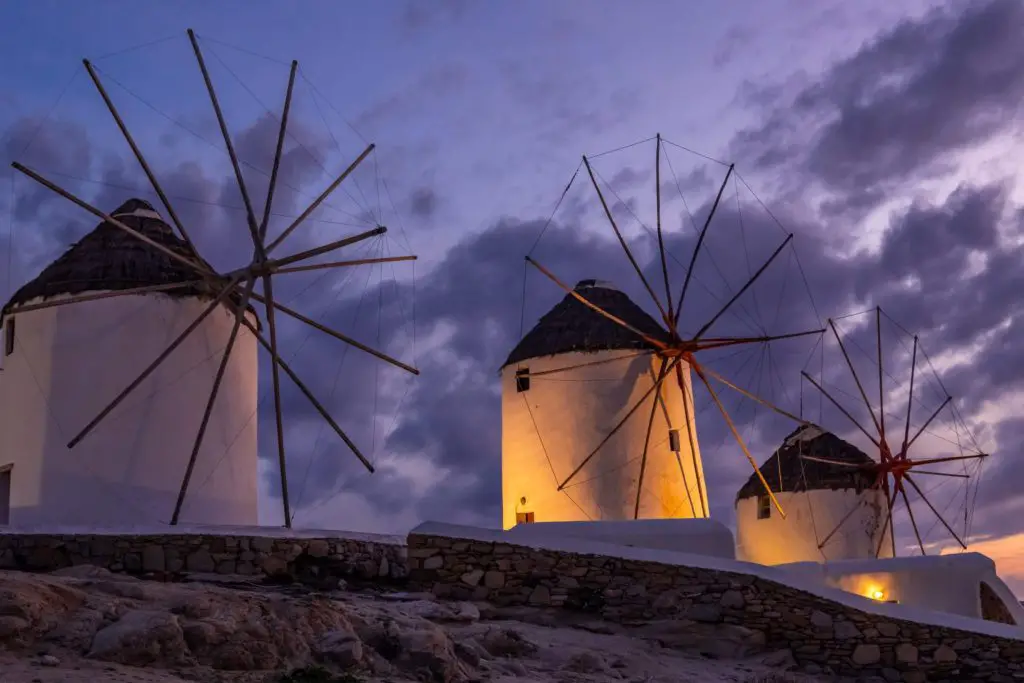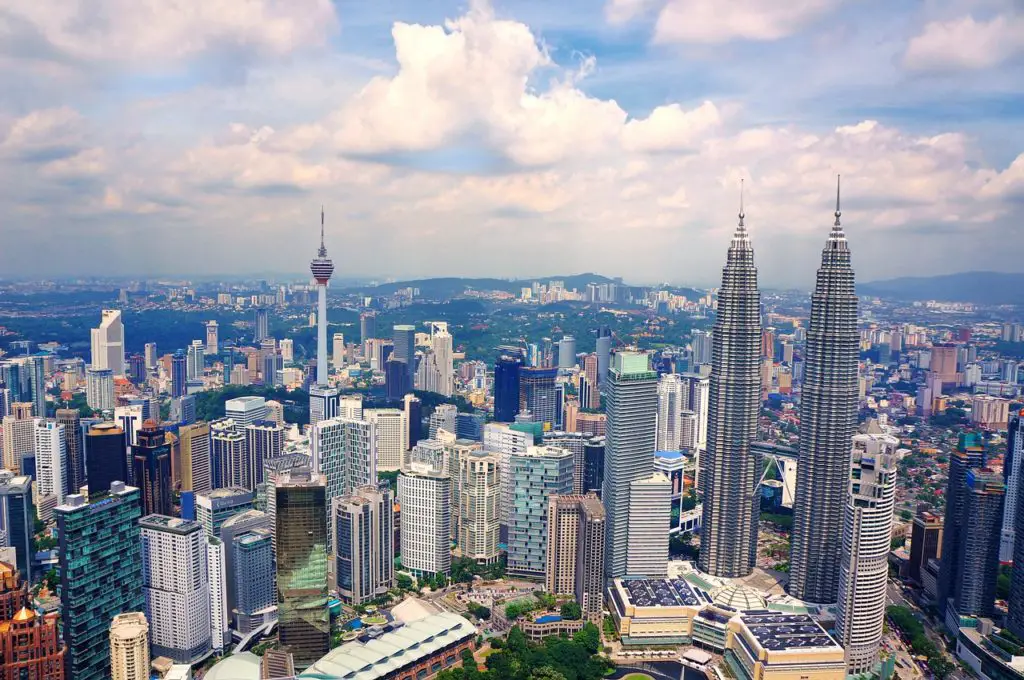This “island of the winds” was once a popular hangout for pirates during the early 1900s and is now a vacation spot for celebrities, since the 1950s. So, what can you do with the 3 days in Mykonos?
Plenty! We covered the must-visits on our first day and spent our last day exploring the two major museums on the island. Our highlights were:
- Windmills of Mykonos
- Panagia Paraportiani Church
- Delos Island
- Aegean Maritime Museum
- Armenistis Lighthouse
These are just some of the questions we answer on Mykonos. Éla! Akolouthíste me se mia peripéteia sti Mýkono! That means, “come! Follow me on an adventure in Mykonos!”.
Disclaimer: Some of the links here are my affiliate links and I may earn if you click on them, AT NO EXTRA COST to you. Please read my Disclaimer Policy for more information. Hope you find the information here useful! Thank you!
Where is Mykonos?
Mykonos is part of the Cyclades and lies between Tinos, Syros, Paros, and Naxos. The highest elevation stands at 341 meters and the most populated town is Chora which is on its west coast.
The island has a semi-arid climate that is influenced by the Meditteranean Sea and has about 300 days of sunshine a year with the rainy season falling from October to March. Mykonos has a rocky terrain that is composed of granite.
Although famous for its beaches and nightlife, the island is also a popular destination for the rich and famous. Tom Hanks, Shakira, Harrison Ford, Sarah Jessica Parker, and Hugh Jackman have all been spotted shopping or relaxing here.
History
Historically, the earliest inhabitants of Mykonos were the Cares, Phoenicians, Egyptians, and then Minoans who were followed by the Ionians. Mykonos was part of the Byzantine Empire until the island was ravaged by Catalans in the 13th century.
The island was under direct Venetian rule until the Ottoman fleet of Suleiman the Magnificent established themselves on the island. Until the end of the 18th century, Mykonos prospered as a trading center, attracting both immigrants and pirates.
It was local heroine, Manto Mavrogenous who sacrificed her family fortune for the Greek Revolution. The central plaza in Mykonos bears her name and her bust is placed at the center of the square.
By the 1960s, Mykonos was already popular with international jet setters and by the 2000s, Mykonos had already been established as a popular gay-friendly destination, and one of the most expensive islands of the Cyclades.
Myths of Mykonos
According to local legends, Mykonos is named after Mykons, the grandson of Apollo and the first ruler of Mykonos. As for the rocks scattered around Mykonos, another myth says that the rocks are the remains of petrified giants.
The story goes that in Greek mythology, there was once a battle between the Gods and the Giants. Zeus gave Hercules the task to destroy the Giants who were believed to be invincible. Hercules lured the Giants to Mykonos where he killed and buried them under the enormous rocks.
Visa Requirements
It is the Ministry of Foreign Affairs that manages the visa applications for both Greeks and foreigners. To determine if you require a visa to enter Greece, you can check based on your nationality.
Schengen Visa
Greece is part of the 26 countries that make up the Schengen Area and is a member of the European Union. These are the countries that need a visa to enter the Schengen Area.
Take note that although some nations are privileged to enter the Schengen visa-free, other nations would need to fulfill all the requirements before any permit can be granted.
European Travel Information And Authorization System (ETIAS)
The European Travel Information and Authorization System (ETIAS) is a visa-waiver program for those who can enter Greece visa-free.
This means that although you can enter Greece visa-free, you would still need to complete the ETIAS Visa Waiver for Europe. At the moment, you can apply for a notification as to when this system would be operational.
If all this seems too much, you can always use iVisa Greece to assist in your visa application needs. Their system is fast, easy, and the best part is that they have a 24/7 customer support team who are always ready to help.
Which airport do you fly into for Mykonos Greece?
You fly into Mykonos Airport (JMK) which is about 2.2 miles from the Mykonos Old Port town. The other smaller airports near Mykonos are Paros (PAS), Santorini (JTR), Chios (JKH), and Athens (ATH).
How do I get around Mykonos?
There are several ways to get around in Mykonos. These are by:
Bus
Mykonos has a comprehensive bus network thanks to the services of KTEL Mykonos. The bus services cover the major areas of the Old Port, New Port, Ano Mera, and Fabrika with routes to the major tourist beaches on the island such as Paradise and Super Paradise.
Take note that bus services to the north and east coast of Mykonos are sparse and almost non-existent.
Car
The best and most convenient way to see the island on your own and at your own pace is by renting a car. You can check out Rental Cars to pick up your car from anywhere in Mykonos and drop it off anywhere convenient to you.
Take note that during the summer months, you would have to deal with peak-season traffic and limited parking locations throughout the island. The roads are also narrow and there is a heavy fine for parking at an unapproved spot.
Walk
The beach walk between Platys Gialos and Paradise Beach is one of the highlights of Mykonos. The other area where beach walks are possible is from Ornos to Super Paradise Beach. As there are no proper walking trails, walking is not recommended. And, the roads are narrow and busy which makes walking dangerous.
Boat
Mykonos Sea Transfer has a daily sea taxi service to the major beaches on Mykonos. The sea taxi begins from Ornos and goes to Platys Gialos, Paraga, Paradise, Super Paradise, Agrari, and Elia.
The Mykonos Sea Bus is the only fast and reliable transportation between the Old Port of Chora to the New Port of Tourlos. It is also cheap and costs €2 ($2.25) per person.
Taxi
There are only about 30 taxis in Mykonos and you can find them behind the Cosmote building at the north entrance of Mykonos Town and next to the southern bus station. In both areas, you can find long queues.
Although Uber is available in Athens, there is no Uber in Mykonos. The alternative ride-sharing applications which you can use are Aegean Taxi and iMove.
Motorbike/Scooter
Motobikes or scooters are an excellent alternative to driving. Not only can you cover every nook and cranny of Mykonos, but you are also assured that parking would be so much easier.
However, take note that you need to have a valid motorcycle driving license in your home country before you can drive in Mykonos. To book a motorcycle or scooter, Bikes Booking has several options you can use when in Mykonos.
Airport transfer
The easiest way to get from the airport to the city is through an airport transfer. You can pre-book your Mykonos Airport Transfer to get you to your hotel safely.

Is there Uber in Mykonos?
No, Uber is not available in Mykonos and is only available in Athens. You can download the Aegean Taxi and iMove as these providers are similar to Uber in that you can access taxi drivers that are within your neighborhood.
How do I spend 3 days in Mykonos?
With our 3 days in Mykonos, you can visit the famous landmarks on the island and still have a full day trip to Delos to savor its historical atmosphere. On our last day, we relax as we explore the museums and end our day with the picture-perfect sunset at Cape Armenistis.
Day 1: Must-Visit Landmarks
On Day 1 of our 3 days in Mykonos, we visited the 3 must-visit landmarks on the island. These landmarks are not only iconic but also spiritual and reflect the history and culture of the island.
Windmills of Mykonos
The first of our 3 days in Mykonos is the Mykonos windmills. As you come into the harbor from Alefkandra, the first thing you would see are the windmills. These windmills face North where the winds are the strongest for most of the year.
These mills were built by the Venetians during the 16th century and were primarily used to mill wheat, which was an important source of income for the early inhabitants of the island. Although these windmills are iconic for Mykonos, windmills can be found on almost all islands on the Cyclades.
Do the windmills in Mykonos work?
The windmills are no longer in operation. However, one the windmill, the Bonis Windmill is now a museum.
What are the windmills in Mykonos called?
The windmills are “kato mili” for “the mills down below”. While the mills near the port are known as “pano mili” for “the mills high up”.
How many windmills are there in Mykonos?
There are 16 windmills in Mykonos, of which, seven are at a landmark hill in the town of Chora. Read the Windmills of Mykonos: The History of a Landmark to know more.
Matoyianni Street
The second of our 3 days in Mykonos is Matoyianni Street. This shopping street is a 7-minute walk from the Windmills of Mykonos and is known as the “heart of Mykonos”. From high-end designer stores to local handmade items, you can find them all here.
And, if you are lucky, you can see Tom Hanks or Sarah Jessica Parker walking along this narrow alleyway. The street is known to be crowded during the summer months, take a break at the restaurants or traditional Greek tavernas to savor Greek delicacies such as souvlaki.
What are the streets in Mykonos made of?
Whitewashed homes, pebbled streets, and bougainvilleas hanging from balconies are what the streets of Mykonos are made of. The blue doors and windows against white walls are architectural landmarks across the Cyclades Island Group, from Santorini, Tinos, and Milos.
Read Why Are Buildings in the Cyclades Painted Blue and White and The Secret Charm of the Mykonian Architecture to know more.
Panagia Paraportiani Church
The third of our 3 days in Mykonos is the Church of Panagia Paraportiani. This iconic church is an easy 5-minute walk from Matoyianni Street. Another name for this church is “Our Lady of the Side Gate” as its main entrance is from the side gate entry to the Kastro area.
The church was built in 1425 and is a combination of four churches joined together. The 4 churches are dedicated to St Eusthathios, St Sozon, St Anastasia, and St Anargyroi and the fifth church that is built above these four are the Church of the Virgin Mary which has a dome.
If you are lucky, you can spot Mykonos’ mascot, Peter the Pelican, lounging by the sidewalls that overlook the Aegean Sea.
There is no entrance fee to visit the church and the church may not always be opened during your visit. However, you can easily spend 15-minutes walking around the area and looking out to the Aegean Sea.
How many churches are there in Mykonos?
There are at least 1,200 churches in Mykonos. This means that each family has at least one chapel at home. However, not many of these chapels hold services. These chapels are built facing the sea so that sailors have a safe voyage and return home.
Why does Mykonos have so many churches?
This dates back to the tradition of enshrining the bones of the dearly departed within the walls of family temples. This tradition continues today with the chapel within home being the focal point for religious feasts and festivals that are held throughout the year.
Some other churches that you can visit are the Church of St Nicolas, the Church of Virgin Rodario, and Panagia Rosario.
Day 2: Delos Island
On Day 2 of our 3 days in Mykonos, we take a day trip to Delos to explore its historical ruins and one of Greece’s UNESCO Heritage Sites.
The fourth of our 3 days in Mykonos is a day trip to Delos. This island was initially inhabited by the Carians since the 3rd millennium BC and several “purification” ceremonies were held to turn the island into a proper island fit for worship to the gods.
During the Roman era, the island was turned into a port and the island became a premier trading center for the Romans. Due to the change in trading routes, the island went into decline and was eventually abandoned by the 8th century.
Did you know that there was a prohibition on dying and giving birth on the island to maintain its sanctity?
Some of the earliest known “purification” included removing all dead bodies on the island and re-burying them on another island. A further purification included removing all inhabitants to another island.
Why was Delos so important?
Delos is important as it is the place where Titaness Leto was revered. She was the mother of twin gods, Artemis and Apollo. The island was also an important religious pilgrimage center for the Ionians by 100 AD.
How long do you need in Delos?
You would need at least 3 hours to take in the views and photographs. Don’t forget to wear a good pair of walking shoes as there is plenty of walking.
What is the curse of Delos?
The curse of Delos is a yellow daisy that is believed to have sprouted on Delos during the birth of Apollo and Artemis. Why is it a curse?
According to myth, Delos was once an “unanchored” island, which meant that the island floated freely in the ocean. The story goes that Zeus impregnated Leto, the Titan goddess, and this angered Zeus’s wife, Hera.
Hera went to her grandmother Gaia and placed a curse to deny Leto any land to give birth on. However, Poseidon directed Leto’s boat towards Delos, which was unanchored and did not fall as “land”. This circumvented Hera’s curse and the twins were born.
After the twins’ birth, Leto blessed the island with pillars and as a show of happiness, the island was covered in yellow daisies.
How much is the ferry from Mykonos to Delos?
A round-trip ferry ticket from Mykonos to Delos costs €22 ($25) for adults and €11 ($12) for children between the ages of 6 to 12 years. There is no entrance fee for children below the age of 6 years.
Day 3: Museums of Mykonos
On Day 3 of our 3 days in Mykonos, we explore the museums and end our day with a trip to the lesser-known Armenistis Lighthouse.
Aegean Maritime Museum
The fifth of our 3 days in Mykonos is the Aegean Maritime Museum. The museum was founded with the purpose to preserve, promote, and study Greek maritime history. The museum specializes in the merchant-ship history of the Aegean Sea.
Some of the living exhibits that were restored include the original Armenistis lighthouse, the Thalis o Milesios which is a cable-laying steamship that was built in 1909, and the Evangelistria which is the last Perama style that functioned as a cargo vessel.
How much is the entrance fee to Aegean Maritime Museum?
The entrance fee is €4.00 ($4.50) and €2.00 ($2.25) for children. The museum is open daily from 10.00 am to 1 pm and 6.30 pm to 9 pm in summer. In winter, the hours are from 8.30 am to 3 pm. The address of the museum is 10, Enoplon Dynameon Street, 84600 Mykonos.
Archaeological Museum of Mykonos
The sixth of our 3 days in Mykonos is the Archaeological Museum of Mykonos. This museum is 1-mile from the Aegean Maritime Museum and is either a 10-minute walk or a 6-minute drive.
The museum is one of the oldest in Greece and was built to house the artifacts from the Putrefaction Pit of 425/426 BC which was discovered on the Isle of Rheneia. The museum also houses a large number of vases from the prehistoric to the late Hellenistic period (3,000 to 1st century BC).
Among its prized possessions is the vase that depicts the fall of Troy using the Trojan horse that dates back to the 7th century. The grave stele of Glykon and Tertia Horaria are other possessions that date back to the 2nd century.
How much is the entrance fee to the Mykonos Archaeological Museum?
The entrance fee is €4.00 ($4.50) for adults and €2.00 ($2.25) for children. The museum is open daily from 8.30 am to 4 pm in summer on Monday, Wednesday, Thursday, and Sunday.
In winter, the museum is closed from November to the end of March. The address of the museum is Old Port of Chora, 84600 Mykonos.
Armenistis Lighthouse
The seventh and last of our 3 days in Mykonos is Armenistis Lighthouse. This lighthouse is a 15-minute drive from the Archaeological Museum and is located in Fanari, about 4 miles from Chora, Mykonos.
The lighthouse is still in operation although the lighting mechanism has been upgraded to modern electrical equipment. The original lighthouse with its traditional mechanism is at the courtyard of the Aegean Maritime Museum.
History of Armenistis Lighthouse
It was the sinking of Volta, the British steamship that killed 11 people in 1887 that prompted the building of this lighthouse. By 1891, the lighthouse was standing at 19 meters became a beacon that guided ships towards safety.
What is the best time to go to Mykonos?
The spring months of March to May and the early rain bring the bloom of wildflowers as the weather begins to warm. This is one of the best times to visit Mykonos as school is still in session. This means that there is less crowd and the prices are generally lower. The weather continues to improve in April and the waters may be chilly for swimmers.
The end of the “shoulder season” is your last chance to savor Mykonos on a bargain. The summer months of July to August is peak season which is the best time for partying. Be prepared as the crowds began to arrive.
Fall begins in September and October and is considered “shoulder season” as the party-goers gradually leave. These months are the best time for budget travelers as prices begin to decline. November brings cool and clear weather across the island.
If you are looking for a peaceful Mykonos holiday with bargain prices, then the winter months of December to February are the best times for you. The temperatures are warm in the coastal cities. However, you can expect limited ferry services and fierce storms during these months.
What is the hottest month in Greece?
August is the hottest month in Greece with an average temperature of 28.7°C (84°F). Athens is the second hottest city in Europe with highs of 30°C with hot and dry weather.
What is the coldest month in Greece?
January is the coldest month in Greece with an average temperature of 9.5°C (49°F) in Athens. During the winter months, there are short periods of rain with cold air masses coming from Russia and Northern Europe which makes temperatures drop even further.
Frequently Asked Questions (FAQs) on Mykonos
We know you may have other questions on Mykonos, other than those featured in our 3 days in Mykonos guide. We hope you find this information useful!
What do I need to know before going to Mykonos?
Mykonos is as exciting as it gets. It is a global destination that attracts tourists every year and with its international airport, Mykonos is accessible from almost all major cities.
Here are some things which you need to know before making your way to Mykonos. These are:
- Party. During the peak summer months of June to September, the town does not sleep with beach parties starting right after sunset until dawn, the next day. These months are popular as international DJs flock to the island to play at the many clubs and gay-friendly bars on the island.
- Currency. Mykonos in Greece is part of the European Union which means the currency used here is Euro (€). You will not have any problems with international debit or credit cards, however, it is best to carry some cash with you, just in case.
- Diving. Mykonos is the perfect destination for divers, from beginner to advanced. With plenty of wrecks and dive sites across the island, why not go diving while you are there.
- Photography. This party island is just as beautiful as the photos you see all over the web. With stunning sunsets and clear blue skies, this is a place where you have to see for yourself.
- Food. The food in Greece is similar to other Mediterranean cuisine and consists of olive oil, wheat, and wine. Check out the 10 Best Restaurants on Mykonos, Greece to know more.
Read the Top Reasons Why You Should Visit Mykonos, Greece to know more.
Is Mykonos just a party island?
While Mykonos is known as a party capital that is frequented by millionaires and billionaires, it is often compared to Ibiza, which is the party capital of the world with 24-hour nightclubs and pool parties.
To say that Mykonos is purely a party island would be understating the island’s historical and natural landmarks. This “Island of the Winds” has swanky hotels, whitewashed alleys, and areas that are still untouched by tourism.
Read the Ultimate Guide To Mykonos In Pictures: More Than A Party Island and the 7 Best Greek Islands For Partying to know more.
How much is a Coke in Mykonos?
According to Numbeo, a can of coke in Mykonos costs €3.50 ($3.96) while a combo meal at McDonald’s costs €9.00 ($10.18).
How much money should I take to Mykonos for a week?
According to Budget Your Trip, a one-week vacation in Mykonos costs about €832 ($953) for one person and €1,665 ($1,906) for a couple. A typical double-room occupancy cost of €118 ($135) is the average you can expect.
How long does it take to travel around Mykonos?
With a length of 9 miles and a width of 6 miles, Mykonos is one of the smallest islands among the Cyclades. If you were to drive around the island, it can take up to 2 hours and 4 hours, if you plan to stop at beaches.
Does Mykonos have sandy beaches?
Whether you are looking to swim, sunbathe, or party, Mykonos has plenty of sandy beaches to choose from. The most beautiful beaches of Psarou, Platis Gialos, Paraga, Paradise, and Super Paradise are all on the south coast of Mykonos.
The lesser-known beaches of Fokos, Ftelia, Panormos, and Agios Sostis are on the north coast of the island. Mykonos town beach is a small beach on the harbor front while Megali Ammos is just a 10-minute walk from Mykonos town.
Read the 8 Great Beaches In Mykonos to know more.
What language do they speak in Greece now?
The language of Greece is Greek which is spoken by 99% of the population. The other languages spoken are English, German, French, and Italian. These are the common foreign languages spoken by the minority in Greece. Read the 19 Essential Greek Phrases You Need To Know before visiting Mykonos.
Do they speak English in Mykonos?
Yes, English is spoken in Mykonos. Even the menus are in English. Spoken English is between moderate to advanced levels. The youngsters are fluent in the language when compared to the older generation who may still converse in Greek.
Is Mykonos worth visiting?
Yes! Mykonos has its fair share of historical sites, beautiful beaches, and museums and is known as a party island. And, it’s a paradise for foodies where you can eat the freshest seafood and mingle with the friendly locals.





